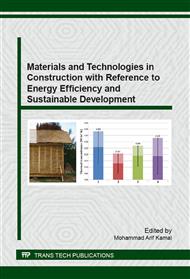[1]
Othman, M. R., Zakaria, R. and Fernando, W. J. N. (2009). Strategic Planning on Carbon Capture From Coal Fired Plants In Malaysia and Indonesia: A Review. Energy Policy, 37(5), 1718-1735.
DOI: 10.1016/j.enpol.2008.12.034
Google Scholar
[2]
Mejeoumov, G. G. (2007). Improved Cement Quality and Grinding Efficiency by Means of Closed Mill Circuit Modeling, Doctoral dissertation, Texas A&M University.
Google Scholar
[3]
Hopkins, D. S., Thomas, M. D. A., Oates, D. B., Girn, G., and Munro, R. (2001). York University uses High-Volume Fly Ash Concrete for Green Building. Proceedings-Canadian Society for Civil Engineering.
Google Scholar
[4]
Malhotra, V. M. (1994). CANMET Investigations Dealing with High-volume Fly Ash Concrete. Advances inConcrete Technology, 2, 445-482.
Google Scholar
[5]
Malhotra, V. M. (1990). Durability of Concrete Incorporating High-Volume of Low-Calcium (ASTM Class F) Fly Ash. Cement and Concrete Composites, 12(4), 271-277.
DOI: 10.1016/0958-9465(90)90006-j
Google Scholar
[6]
Sirivivatnanon, V., CaO, H. T, Khatri, R. P. and Bucea, L. (1995). Guidelines for the use of high volume fly ash concretes. CSIRO, Division of Building, Construction & Engineering, Technical Report TR95/2.
Google Scholar
[7]
Balakrishnan, B. and Awal, A. S.M.A. (2014). Durability Properties of Concrete Containing High Volume Malaysian Fly Ash. International Journal of Research in Engineering and Technology, 3(4): 529–533.
DOI: 10.15623/ijret.2014.0304093
Google Scholar
[8]
ASTM C150 (2012), Standard Specification for Portland Cement. American Society for Testing and Materials.
Google Scholar
[9]
BS EN 12350-2 (2009). Testing Fresh Concrete. Slump-test. British Standard Institution.
Google Scholar
[10]
ASTM C403 (2008). Standard Test Method for Time of Setting of Concrete Mixtures by Penetration Resistance. American Society for Testing and Materials.
Google Scholar
[11]
BS EN 12390-3 (2009). Testing Hardened Concrete.
Google Scholar
[12]
ASTM C496 (2010). Standard Test Method for Splitting Tensile Strength of Cylindrical Concrete Specimens. American Society for Testing and Materials.
Google Scholar
[13]
ASTM C469 (2010). Standard Test Method for Static Modulus of Elasticity and Poisson's Ratio of Concrete in Compression. American Society for Testing and Materials.
Google Scholar
[14]
ASTM C618 (2012). Standard Specification for Coal Fly Ash and Raw or Calcined Natural Pozzolan for Use in Concrete. American Society for Testing and Materials.
DOI: 10.1520/c0618-15
Google Scholar
[15]
Duran-Herrera, A., Juarez, C. A., Valdez, P. and Bentz, D. P. (2011). Evaluation of Sustainable High-Volume Fly Ash Concretes. Cement and Concrete Composites. 33(1): 39–45.
DOI: 10.1016/j.cemconcomp.2010.09.020
Google Scholar
[16]
BS 5328, (1981). British Standard Institution.
Google Scholar
[17]
Khan, M. S., Prasad, J. and Abbas, H. (2013). Effect of High Temperature on High-Volume Fly Ash Concrete. Arabian Journal for Science and Engineering, 38(6), 1369-1378.
DOI: 10.1007/s13369-013-0606-1
Google Scholar
[18]
Sarshar, R. and Khoury, G. A. (1993). Material and Environmental Factors Influencing the Compressive Strength of Unsealed Cement Paste and Concrete at High Temperatures. Magazine of Concrete Research, 45(162), 51-61.
DOI: 10.1680/macr.1993.45.162.51
Google Scholar
[19]
Chan, Y. N., Luo, X., and Sun, W. (2000). Compressive Strength and Pore Structure of High-Performance Concrete after Exposure to High Temperature Up To 800oC. Cement and Concrete Research, 30(2), 247-251.
DOI: 10.1016/s0008-8846(99)00240-9
Google Scholar
[20]
Awal, A.S.M.A. and Shehu, I. A. (2015). Performance evaluation of concrete containing high volume palm oil fuel ash exposed to elevated temperature. Construction and Building Materials, 76(2), 214-220.
DOI: 10.1016/j.conbuildmat.2014.12.001
Google Scholar


